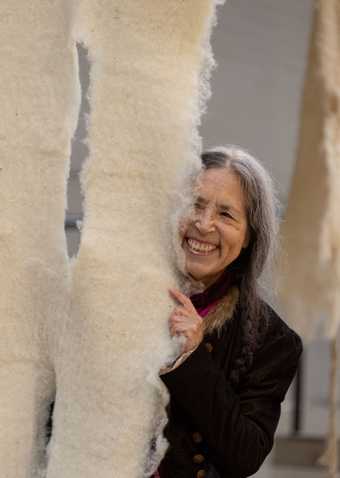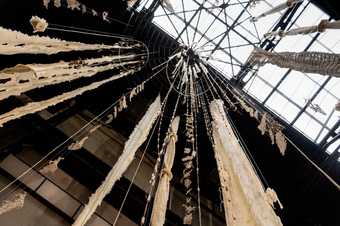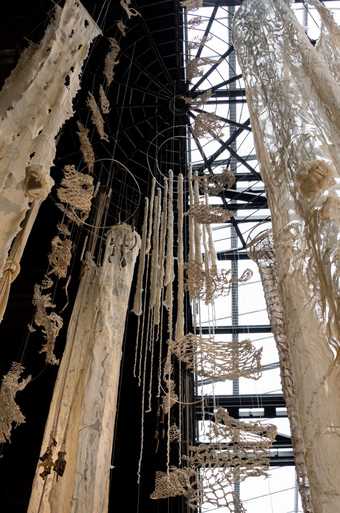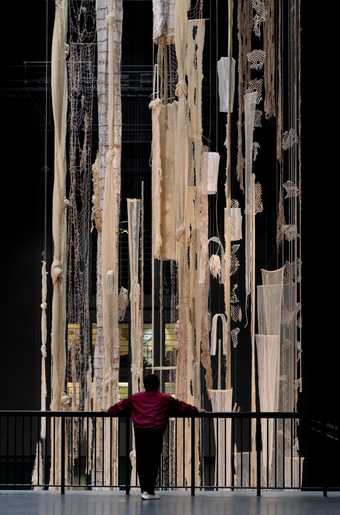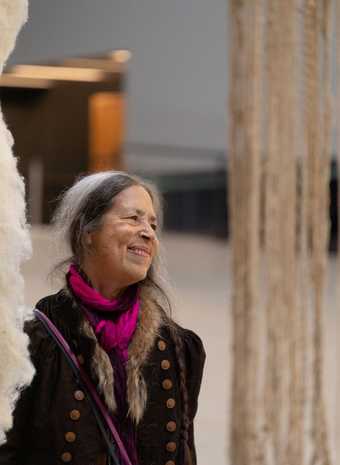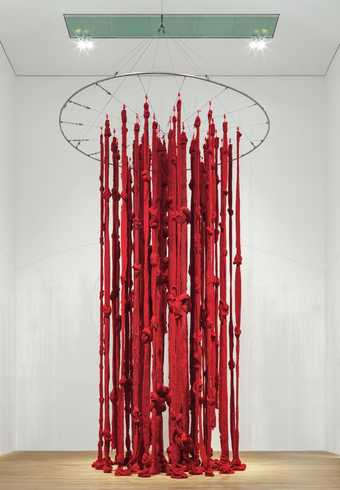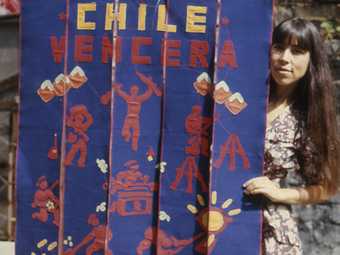Audio list
4 stereo tracks of approximately 8 hours each, containing 168 sound files from 23 contributors and 1 archive (played from within the 'Dead Forest Quipu'); and one 8 hours quadraphonic sound file (played underneath the Turbine Hall bridge)
Concept by Cecilia Vicuña
Directed by Ricardo Gallo
Designed and arranged by Ricardo Gallo and Ariel Bustamante with contributions listed below
External Project Researcher: Miranda Samuels
Below is a series of descriptions from the artists. Compiled by Ricardo Gallo.
Benjamin Calais
El Silencio - Magdalena Medio – Colombia (Circadian Field Recordings from Colombia)
This 24-hour recording I made, is an opportunity for you to travel and connect sonically with the deep wilderness of Colombia. Selected 8 hours (of 24 hours) recording of El Silencio Natural Reserve in the region of Puerto Berrio, Magdalena Medio, Colombia. Location: 6°47'40.23"N - 74°13'9.09"O March 18th, 2021. The original recordings are made in a quad omni cross recording setup. The selected fragment of 8 hours corresponds to the times the museum is open, and it is played quadraphonically under the Turbine Hall’s bridge.
Special thanks to Oscar Laverde, Fernando Arbelaez and Santiago Rosado.
Yao Chunyang
Post-Oblivion and AyuDabuya
Post-Oblivion is a Suite of electronic music based on field recordings made in Shiraoi, Hokkaido, Japan. The work includes the sounds of geyser, crows, and seagulls. Shiraoi is inhabited by the Ainu people, who worship bears and derive their food and aesthetics of dress and adornment from nature. The composer herself, a Naxi (an ethnic minority from Lijiang of Yunnan Province, China) uses the Naxi proverb 'All food and clothing comes from the land,' throughout the five pieces. The Naxi language is interpreted and broken down in the field recordings of Shiraoi, expressing the similarity of ecological views of nature among ethnic minorities in different countries, that we rely on nature for survival and believe in its power.
AyuDabuya is a recording of an improvisation with vocals, noise and synthesizer, the title has no meaning, it is the composer’s daughter who is 4 years old said after hearing the recording that 'AyuDAbuya' should be the name of the song.
Diego Espinosa
Paisaje de Gongs and Ícaro de Diego are dedicated to Cecilia Vicuña and all the cultures that inspire her work.
Paisaje de Gongs is a moment of reflection of the passing of time. Ícaro is a fragment of an invocation that came to me spontaneously during a ceremony. That melody has accompanied me for a few years dancing within my mind from time to time. The time has come for it to inhabit other spaces.
Julián Gallo
The following pieces: ‘Pasión de Cristo Sta. Maria’, ‘Alabaos Pasión y grillos Sta Maria’ [alabaos (worship chants) and crickets], ‘Alabaos Acercándose Pasión Sta María’ [alabaos approaching], recorded in 2017, are mini sonic “x-rays” of moments that only occur during holy week, in which a particular marimba playing is heard in that time of the year, with the church’s marimba that is taken outside each year for these celebrations. This happens in the middle of the jungle, in a remote place, Santa María de Timbiquí, Cauca, Colombia.
The piece ‘Baila Juana’ (2017) features Justino Carabalí playing Marimba de Chonta and is included in the album Espíritu Balanta y Estrellas de Timbiquí.
I am also including a couple of recordings of a thrush from Villeta, Cundinamarca, Colombia, recorded in 2021.
Ricardo Gallo
With Cecilia Vicuña we recorded 6 pieces dedicated to the forest, to the trees, to human life, to water as source of life.
These are: ‘Tree Truth’, ‘Human Nature’, ‘Arbol de vida’, ‘Semen de la selva y de las palabras’, ‘humano’ and ‘Madre’. She records her voice and poems that I later and treat in an exchange that is based on deep listening. I offer also ‘Paisaje Cundibuyacense’ a soundscape with my favourite birds (including the 'copeton' or rufous-collared sparrow, the songbird I first remember from childhood), and frogs from different towns of Cundinamarca, Colombia (close and around Bogotá).
Tomoko Hojo
‘fall asleep’ (2021)
There is a special bell at my home, where a Buddhist temple lasts more than 500 years. It is made of a copper alloy with traces of silver, and only used when a Buddhist monk and its partner are passed away, in front of their dead bodies with chanting. In other words, I will only hear this the sound when my parents are dead. The bell’s sound, vibration and ripples delivered by a living person would softly touch to their freshly dead, sleeping bodies. Do sounds reach dead body? Do sounds reach sleeping body?
‘In a middle of cornfield’ (2021)
As a remote project organised under C-19 situation, this piece is created based on field recordings by Jixing, a local informant of the Naxi people at China’s Yunnan province. Reflecting on characteristics of this tribe, which are Dongba religion and matrilineal society, I focused on their conflicts, anxieties, and hopes emerges between the capitalism and the local tradition, and the ideal and the reality that each generation have.
‘Whispered Screaming’ (2022)
This is an extract from a performance, 6-channel surround audio system with a playback and a live vocal. Based on the research of Yoko Ono’s screaming, I extracted all screaming parts from her discography and re-recorded it with using my own whispering voice, yet trying to scream. Thus, lots of air pressures are on a throat and sometimes unexpected sounds are created, which sounded like a trumpet, a tiger or a bird. As screaming itself is common act for animals, thus these uncontrollable voices often associate with the other beings, which might include some spiritual beings too.
Germán Lázaro
The urus are played since immemorial times in the music of ‘Tarqueada’, specifically in the spring and summer time during carnivals. In that way, up until today we have been practicing this kind of music. The seven pieces included are my compositions, the recording was done in Chipaya, Bolivia by Ariel Bustamante.
Sheryl Cheung
‘Earth Crust Quake’ from my project Anthem Boy
It speaks to how all powers/wills in nature, including men, are intertwined in a network of mobilities
Original composition (Some elements in this piece utilized sounds from the BBC's free sound archive)
For more information visit lololol.net
André Magalhães
Music track edited using the collection of Aldeia Multiétnica (Brazil) and the film O Destino está na Origem, directed by Pedro Guimarães. Featuring Indigenous people Kayapó, Krahô, Karajá, Walapti, Guarani, Kariri Xocó, Fulni-ô. Hanicuim, Maxakali and Caixeiras do Divino Espírito Santo da casa Fanti Ashanti (Maranhão) - Zezé Menezes de Iemanjá e Graça Reis.
In an Indigenous meeting with several native ethnicities that takes place every year in Brazil, state of Goiás, Chapada dos Veadeiros in the city of Alto Paraíso, conversations, rituals and recordings are held with the Indigenous people present. A hut in a traditional format is built on the site by the natives and inside it is formed into an audio and video studio where recordings are made for the collection. Each year, a theme is also chosen to create something collectively, always with the aim of strengthening the culture of Indigenous peoples. In 2019, in addition to all the recorded songs, a joint song was produced where the Multiethnic Orchestra was formed with the Kayapó, Krahô, Karajá, Walapti, Guarani, Kariri Xocó, Fulni-ô ethnicities. Hanicuim, Maxakali, and a popular manifestation from north-eastern Brazil called Caixeiras do Divino Espírito Santo from the state of Maranhão.
Project Direction: Juliano Basso and Pedro Guimarães
Music production, recording and mixing: André Magalhães
Artistic Direction and Conducting Multiethnic Orchestra: Renata Amaral
Recording Assistants: Raquel Diógenes, Eduardo Kolody, Cristóforo and Vanessa Louise
Claudio Mercado
(Providing recordings from the Chilean Museum of Pre-Columbian Art audio visual archive, personal recordings and other sources. The titles are in the original Spanish):
- Saludo de los alféreces (baile chino singers) Juan Cisternas y Carlos Bernales en la fiesta de Loncura
In the “chino” parties in central Chile, the “bailes” from different towns encounter and greet each other dancing and playing their flutes. Then the singers of each “baile” start a conversation singing in improvised quatrains, saluting. Recorded by José Pérez de Arce. Chilean Museum of Pre-Columbian Art audio-visual archive. 1993. - Catarreando en Pachacamita
The flutes used in today’s “bailes chinos” in Central Chile are descendants of the prehispanic flutes that sounded in the territory more than 500 years ago. There is a great aesthetic command of the sound and different kinds of flutes. Here we can hear the sound of a catarra flute which has a very specific function in the dance and has a special sound. Recorded by Claudio Mercado, Chilean Museum of Pre-Columbian Art audio-visual archive. 1994. - Baile chino El Carmelo tocando a difuntos
When a member of a “baile chino” from central Chile dies, the pain is expressed through a special playing of the flutes. A slow and controlled sound, making the flutes cry. Recorded by Gerardo Silva and Claudio Mercado, Chilean Museum of Pre-Columbian Art audio-visual archive. 1999. - Bailes chinos del Aconcagua Chile central
A mix of several “bailes chinos” from the Aconcagua valley in central Chile, one playing after the other, evidencing the differences of sound of each “baile”. These differences are a local identity mark, each baile pertains to a town, each town has its own sound. Recorded by Gerardo Silva and Claudio Mercado, Chilean Museum of Pre-Columbian Art audio-visual archive. 2004. - Bailes chinos en Petorca
This recording captures a fragment of the procession that goes through Petorca town, Central Chile, with several “bailes chinos” sounding at the same time. Recorded by José Pérez de Arce, Chilean Museum of Pre-Columbian Art audio-visual archive.1992. - Alfereando en la mar. Alfonso Galdames. Las Ventanas, Central Chile.
We are inside Alfonso Galdames - Quilama’s boat, famed representative of the “bailes chinos”, sailing by the Ventanas bay. As the moon rises he starts to sing, improvising. The chinos choir that usually repeats his words has been replaced by the sound of water hitting the boat and oar. Recording by Gerardo Silva and Claudio Mercado. Chilean Museum of Pre-Columbian Art audio-visual archive 2001. - Antaras Nazca
Six antara instruments from the Nazca culture (South shore of Perú, 100 BCE. to 650 CE), found together in a tomb. They are played for the first time after restoration. An improvisation with the members of Wayllakepa project, Carlos Mansilla, Milano Trejo, Dimitri Manga, and Alfredo Najarro, and two guests who stopped by that day at the National Archeology, Anthropology and History Museum of Peru in Lima: José Pérez de Arce and Claudio Mercado. Recorded by Claudio Mercado. 2005 - Camaruco en Nahuelpán, Esquel, Patagonia Argentina
Once a year the Mapuche communities celebrate a ritual in gratitude for life and to clamour for strength to carry on. A soundscape full of sounds, pifilcas, cultrunes, trutrucas (Mapuche instruments), chants, yells, wind, horses galloping, rattles. Recorded by Claudio Mercado, Chilean Museum of Pre-Columbian Art audio-visual archive. 2017. - Canto de floreo en Chulluncane, Cariquima, altiplano chileno
A fragment of a “floreo'' celebration, an Aymara ritual to embellish the animals; to the llamas troop. For about five hours now, six or seven bandolas have been sounding nonstop. One of the owner’s daughters starts to sing, improvising, thanking life. Recorded by Claudio Mercado, Chilean Museum of Pre-Columbian Art audio-visual archive. 2004. - Romero romero
A chant recorded in Colchane, an Aymara town in the interior of Iquique, on the Chilean altiplano. Romero romero is one of the chants heard in the Aymara “floreos”, a ritual dedicated to animals. Recorded by José Pérez de Arce, Chilean Museum of Pre-Columbian Art audio-visual archive. 1995. - Carnaval en Cariquima
We are in Cariquima, an Aymara town in the interior of Iquique, in the Chilean altiplano. It’s the carnival celebrations, a collective party of five days and four nights, a collective sound. Here we can listen to bandolas and chants, the carnival couplets. Recorded by Claudio Mercado, Chilean Museum of Pre-Columbian Art audio-visual archive. 1994. - Chercán en Pirque
The cherchán (House wren) is a small bird that sings in the Pirque hills, in a valley near Santiago in Chile. Recorded by Claudio Mercado. - Chineando con antaras Aconcagua
Two stone flutes from the Aconcagua culture in Central Chile. They are about 600 years old and are the precedents of the wooden flutes that are played today. Playing: Guillermo Díaz and Claudio Mercado. Recorded by José Pérez de Arce. Chilean Museum of Pre-Columbian Art audio-visual archive. 2001. - El agua corriendo por los canales del cerro
On Friday mornings I take care of the irrigation water. Through the channels that traverse my hill the little water goes on singing while it moistens the soil, trees and plants. Recorded by Claudio Mercado. - El baile de Pucalán. Claudio Mercado
A long cueca (traditional Chilean dance) that I made in honor of Pucalán’s “baile chino”, in which I have participated as a flute player for 27 years. - El canto del chuncho en Pirque
The chuncho is a species of owl that sings in the Pirque hills, a valley near Santiago de Chile. Is the first bird to sing at dawn and the last to sing at night. Recorded by Claudio Mercado, Chilean Museum of Pre-Columbian Art audio-visual archive. - Estrella del cielo. Félix Panire, Honorio Ayavire
We are in Ayquina, a Lickanantay indigenous town in the interior of Calama, northern Chile, during the “Limpia canales” festivities, a communal yearly ritual in which during the day the irrigation channels are cleaned by the townspeople and at night they dance and sing “Pa atrás pa adelante” and “Ventanas'' accompanied by harps and putus (bovine horns). Recorded by Claudio Mercado, Chilean Museum of Pre-Columbian Art audio-visual archive. 1992. - Flautas matutinas de otoñz
Two reed flutes played in the dawn dance at my hill in Pirque, Central Chile, which later were doubled and multiplied on the computer. Music and recording by Claudio Mercado. 2021 - Gatos cantando en Pirque
Two small cats from a new litter. Do they talk, sing, recognize or intimidate each other? I don’t know but it’s a beautiful and unsettling chant. Recorded by Claudio Mercado, 2020 - Jarros silbato. La Chimuchina
The “jarros silbato” (whistle jars) are ceramic musical instruments, invented about 3000 years ago in Ecuador’s coast. They sound when moving water inside of it. The movement of the water moves the air and it sounds when passing by the whistle. This is an improvisation with the group La Chimuchina. Recorded by Tomás Perez at La Salitrera, Chile. - La caña con choclo. Chosto Ulloa
“La caña con choclo” is the name of a sung melody in the poet style from Pirque, in central Chile, and it is played with a guitarrón, or big guitar, a Chilean instrument with 25 strings. Recorded by Claudio Mercado, Chilean Museum of Pre-Columbian Art audio-visual archive. 2009. - Fragmentos del Mapocho. La Chimuchina
Mapocho is the name of the river that runs across Santiago, Chile, today almost without water. Mapocho is also the name of a concert and a record by La Chimuchina. Here we can hear a fragment of magic reeds and antaras. Recorded by Pedro Santa Cruz at Estudios Oso Pardo. - Lanchas en Cuncumén
“Las lanchas” are dances performed by the peasants and miners in the north of Chile, in nocturnal rituals of “singing to the divine” offered to the virgin Mary. It is played with a transposed guitar; its strings are strummed and its box is hit while the dancer stomps in front of the altar. Recorded by Claudio Mercado, Chilean Museum of Pre-Columbian Art audio-visual archive. 2004. - Loros en el Antivero
“El Antivero” is a wonderful place in the Andes Mountain range in central Chile, from San Fernando inwards. Native forests, birds, waters, stars, and parrots singing in the trees. Recorded by Claudio Mercado. 1999. - La melodía del sol. Honorio Quila
“Singing to the divine” is a ritualistic, poetic, and musical expression of the peasants of central Chile. This is a chant that reminisces Jesus' childbirth but adapted to the context of Chile’s countryside. He is visited by tench, ibises, eagles, and cougars. Recorded by Claudio Mercado, Chilean Museum of Pre-Columbian Art audio-visual archive, January 2000. - Trompeta moche Jaarizada
An improvisation between Claudio Mercado, who plays a replica of a ceramic trumpet of Moche origin (a culture from the north of Peru, (c.0-800 CE)), and Nicolás Jaar, who records and treats the sound with computer software. Recorded by Nicolás Jaar. 2021. - Una noche pircana
A fragment of a night at Pirque’s hills, central Chile. The crickets and the chuncho owl make music so that the stars can move. Recorded by Claudio Mercado. - Pasani. Ursula Calderón
A Yagán chant, a canoeist community in the extreme south of Chile. The chant tells when they were passing by Cape Horn in their little canoes made of tree trunks. Recorded by José Pérez de Arce. Chilean Museum of Pre-Columbian Art audio-visual archive.1994. - Sikuris de Cariquima
The sikuris are groups formed by men who play flutes called sikus and drums simultaneously. They are common in the Andes and they play while dancing in the festivities of the towns’ patron. Cariquima is an Aymara town in the northern Chilean altiplano and the sikuri group is rehearsing to play in the town’s celebration. Recorded by José Pérez de Arce. Chilean Museum of Pre-Columbian Art audio-visual archive.1994. - El Chalinga
The soundscape at Chaliga valley, a tributary of the Choapa river in the North of Chile, is tranquil, natural, gentle, and contains the songs of turtledoves, roosters and thrush. Recorded by Claudio Mercado, Chilean Museum of Pre-Columbian Art audio-visual archive, 2016. - Sumaramansamisa
We are in Chilluncane, an Aymara town in the north of Chile, in the “floreo” celebration, a ritual to embellish the animals; to the llamas troop. Seven bandolas have been sounding non-stop since 12 hours ago. Eventually it Will dawn while we are at 3800 meters above sea level in altitude dancing and singing around a bonfire, fulfilling the ritual sequence of chants dedicated to the animals. The one we can hear here is called Sumaramansamisa. Recorded by Claudio Mercado, Chilean Museum of Pre-Columbian Art audio-visual archive, 1994. - Talatur en Ayquina. Ventura Saire y Salustiano Ansa
We are in Ayquina’s square, a Lickanantay indigenous town, in 1994. It is carnival time. After three days of singing and vigorous couplets - potent in their zest and energy - the talatur (rite to the water) starts and Don Ventura takes the drum and he starts to play softly and to sing. A pinkillo (one hand flute) joins in and the universe starts to oscillate, to lose its definition, to break in a chant that is sad, melancholic, ancient, simple. Recorded by Claudio Mercado, Chilean Museum of Pre-Columbian Art audio-visual archive, 1994. - Toconce de mis amores
Ritual territories, rural histories and sounds. Men and women sing as a choir over the snare drum roll at 3.500 meters above sea level in Toconce town. The choir stops and the Laquitas (ritual dance from the north of Chile) start, full of life, touring the town in the San Antonio celebrations 1994. Recorded by Claudio Mercado, Chilean Museum of Pre-Columbian Art audio-visual archive
Ernesto ‘Teto’ Ocampo
Whenever I feel that there is no photography that could capture a place’s magic, I always tend to record its sound as a way to preserve the energy of a place. Then back in the city, when playing back the recording, I can come back to that spirit, live the multi-dimensional photography that includes flavors, fragrances, and colors. The ambient recording of this piece was finally achieved after several attempts. The place is the [national natural park] Tayrona, my favorite place in the world, that flat space that goes between the [Caribbean] sea and the Sierra Nevada de Santa Marta, sacred mountain, a place home of ancestral communities with spiritual knowledge that still inhabit it and take care of it. In the midst of an indescribable tranquillity by the shore of the soft Don Diego river, at 4 p.m. a solitary Dove appears chanting as if attesting to the peacefulness of that place, the purity of that light, the caress of the breeze. It repeats one note, always the same, and then it leaves a great silence in between each repetition, emphasizing in this way the rest of the sonic universe of the beings awake at that time. That dove is a genius of music and of peace. It turns the instant into the universal symphony by letting us enter it, walk through it, breathe it.
Julie Patton
March in like a Lamb then out like a Lion: A Score to Settle (with humans). Translate by stretching your imagination to grow very big ears to hear the changes to come. Recorded in Cleveland, Ohio, March 21, 3rd year of our covenant w/Covid.
José Pérez de Arce
From Chile, old friend of Cecilia and also long-time music collaborator with her:
- AGUA
Drip from the bathtub, an inexhaustible source of ecstatic inspiration. Recorded and edited overlapping timings and rhythms. (2009) - MAIPO
Recorded at the Maipo river with a contact mic placed in between the rocks in the bottom. Later edited without altering its principal parameters. (2007) - CHILENISMOS
Compilation of quotidian spoken words gathered across Chile and over the years. Using cut and paste only for editing. (2015) - AGUITAI
(with Cecilia and collage) (2009) - KONKONI (2009)
- PLAYA
(with Cecilia) (2009) - ROCAMAR
(song) (2009) - LA SOMBRA
basis for the theme “Under the drum’s shadow”, recorded in Beijing, China, in 1987 and edited in Las Canteras de Colina. - ABRE LA PUERTA
(with Cecilia) Music for the movie “Open the door” by Cecilia Vicuña (2011). - LONCURA
Recorded during the San Pedro festivities in Loncura, 4th of July,1992. The last part of the party, in which 6 “bailes chinos” participated (with flutes) and approximately 12 “bailes danzantes” (with drums), strolling around town, the beach and finishing at the church. - CABILDO
Traditional melody of “singing to the divine” from Cabildo (La Ligua River, Chile) with lyrics by José Pérez de Arce (2009). - Tecnodivino 16
Rap child. My child José is singing, then 4 years old (1998) - PERRITA
(song to his dog) accompanied by the little black dog (2010). - LUSERITO BASE
Rhythmic foundation with a sampler using a “chino” flute sound (2008) - MADRE
Rhythmic foundation based on instruments and a reunion of my family edited with cut and paste (2009) - SIEGO
(song) Traditional tune “La Repetía” with transposed guitar using tuning for “de la Orilla”, and verse by the author (2009) - POSIBLES RITUALES PERDIDOS
Recording with objects, sticks, instruments and voices, with several field recordings done between 1989 and 1992 (1992) - Tecnodivino 26
Melody of “singing to the divine” of Kilimarí, verse by the author (2005) - ANTARA ACONCAGUA
Claudio Mercado and Guillermo Diaz. Two archeological “antaras” made of stone from the Aconcagua period (900 - 1450 DC) from the Santiago Natural History Museum and the Santiago Archeological Museum edited by cut and paste and time compression with computer aid (2002). - ANTARAGUA
Archaeological antaras from the Aconcagua culture (900 - 1450 DC) digitally edited as part of the soundtrack for the movie Konkon by Cecilia Vicuña (2009). - pueta
2 Chilean guitarrones chilenos and palms (2011) - pueta
bandola, Argentinian violin from El Chaco, voice (2011) - pueta
Chinese guzheng and various rhythmic instruments from South America (2011). - SEDISEB
(song followed by field recording) Chilean guitarrón and voice, poem by Cecilia Vicuña and ambient from Las Canteras de Colina (2015). - DIAULO
(short song with marimba) Santos Rubio, voice and Chilean guitarrón, along with marimbas (2002). - Codeguana
(composition with zampollas) Tune of “la codeguana”, from Codegua (Cachapoal), performed with digital sikus (2013). - La del medio
Tune “La del Medio” with Chilean guitarrón. - KIPUFUE
birds (recordings by Guillermo Egli), rhythms, kalimba and other percussion (2009).
Bernardo Rozo López
The seven sent pieces are a product of a very heartfelt collaboration done with Ariel Bustamante. These are very personal invocations which I have been working with in healing ceremonies for a few years now. They come down/emerge from relationships I hold with more-than-human entities as well as relationships I maintain with certain musical-sonic resources that have been previously activated/prepared. With these prayers, through intentional breaths, we blow healing forces directed to either specific places (the forest, the mountains, water) as well as specific things or bodies. The purpose is to contribute to healing of places, things and people from different parts of the planet. Jallalla!
Paulo Santos
‘seeds’:
Instruments produced with seeds and leaves collected in the Amazon Forest compose the base for the floor of bamboo and PVC flutes in a counterpoint between the natural sound of bamboo and the plastic sound of PVC. The digital sound through the composition, opening the way for the pulse of the vibraphone in an intense polyrhythmic path suggesting the advance of deforestation and destruction of forests, rivers and consequential impact on Indigenous peoples. the drum announces possibilities of change and the flutes in a final lament dialogue with the future.
‘trimi’:
the base of this composition is a pvc tube struck with the hand proposing a mantra rhythmic. Angelim's marimba creates a cell melody that is transforming and creating small changes to the route. The instrument that names the song “trimi” created by marco guimarães (a guitar with three strings tune in ( e ) supported by an easel that provides the use of the arc of violoncello to create unique sounds), start with a timbers dialogue in the same instrument that it is being punched with drumsticks on its strings and being touched with the bow creating a sound spatiality. the Syrian drum marks the times now with feet on the ground and open the times for glass marimba played with the fingers on a solo/dialogue with trimi.
Curiosity: ‘trimi’ in Portuguese means shake.
Urian Sarmiento
Some original pieces recorded in Bogotá, and some field recordings of a carnival and nature sounds from Napi, Cauca, Colombia:
- Diocelino Rodríguez Solis, marimba de chonta (marimba made of a kind of bamboo wood named chonta). Bambuco viejo (musical genre). Recorded in San Francisco, Guapi, Cauca, Colombia, 2007
- Town Festivities , Cauca. Recording made by Sonidos Enraizados (record label) in Belén while working on field recordings of the project “Chirimía del río Napi” (2013, río Napi, Cauca)
- Gaita delay. Urián Sarmiento. Original piece
- Gaita melody (original)
- Maraca sound (improvisation)
- Brook at San Agustín (2013, field recording at río Napi, Cauca)
Samita Sinha
‘Suspension ‘considers faith and the creative energy of desire through two lines of voice, using the Hindi alphabet and fragments of an Indian classical composition as material.
Jonathan Skinner
29 field recordings of varying length from several places in the US, France, and the UK where you can hear mostly several species of birds and insects:
- Bandelier Canyon Wrens, New Mexico, 2015
I like it for the raw density of textures interacting, and for the mesmerising song of the canyon wrens among the cliff dwellings at Bandelier National Monument, in New Mexico (USA). - Bempton Cliffs Yorkshire, England, 2021
Nesting auks, gannets, guillemots, and puffins (amongst other seabirds) at the Bempton Cliffs RSPB Preserve in the East Riding of Yorkshire in the Spring (April) of 2021. - Bug Safari Annandale on Hudson, Bug Safari Annandale on Hudson (Bard College) New York 2013
A midnight walk through wet meadows and woods near Bard College on a full moon night in August—taking in the various textures of amphibians (tree frogs) and singing insects (cicadas, katydids, crickets among numerous other species). An extraordinary pulsing of soundscapes. - Carman Valley Meadowlark California, 2012
The resonance of a meadowlark captured with a shotgun mic at dawn in Carman Valley, in the California Sierras. - Cicadas, Cicadas2, Cicada Pharoah, New York, 2013
Some choruses and male courtship “Pharaoh” calls from the Brood X [CHECK] emergence along the Hudson Valley in the Summer of 2013. - Cranes, Nebraska, 2011
Sandhill cranes staging along the Platte River (Nebraska) in 2011. - Dawn Chorus Creuse, France, 2015
A rich forest soundscape on the grounds of an old monastery in central France (La Pree) - Garden Warbler, France, 2015
An exuberant soloist at the old monastery (La Pree) - Gilles Clément’s Meadow, France, 2015
A minute of insect textures from the “raft” (deck) on Gilles Clément’s meadow in movement in central France. - Hermit Thrush Duet, Pecos Wilderness, New Mexico (USA).
Recorded high in the Sangre de Cristo mountains (Pecos Wilderness), Northern New Mexico. - Hermit Thrushes, Maine (USA)
Recorded in Central Coastal Maine. - Insect, Location and date unknown
A delicate insect stridulation. - La Pree, France, 2014
Another soloist at the old monastery (La Pree). - La Pree Chaffinc, France, 2014
A chaffinch singing in the courtyard of the old monastery. - La Pree Sedge Warbler, France, 2014
An incredible performance from the elusive, migratory sedge warbler. - Midlands Woodlands outside Leamington Spa, England (Cubbington Woods), 2016
The soundscape of Cubbington Woods before it was destroyed by HS2. - Nightingale Creuse, NightingaleCreuseShort1, NightingaleCreuseShort2, Nightingale Creuse Shortest along the Creuse River near Fontgombault Monastery in central France, 2016
Various length recordings of nightingales (at close range) singing along the Creuse River in Central France. - Pecos Meadowlark, Pecos Wilderness, New Mexico (2015)
Lots of silence on this recording, interspersed with the ethereal song of the meadowlark, recorded near sunset high atop Trailrider’s Wall in the Pecos Wilderness, 2015 - Rain, Rain2, Location and date unknown
- Raven Fight Pecos Pecos Wilderness, New Mexico (USA)
- River Location and date unknown
- Waterbird La Brenne Central France, 2015
- Strange waterbird recorded at the Brenne nature preserve in central France.
Benjamim Taubkin
From Brazil, original song is a ‘Congado Mineiro’ - from Minas Gerais.
Sinha Rainha is a ‘Congado Mineiro’, a traditional genre from Brazilian music.
This Congado comes from the State of Minas Gerais. These are songs dedicated to the black Virgin.
The story goes that a slave saw in the water the image of a Black Mother Virgin.
When he told the story he was punished. But little by little an Afro-Brazilian tradition took shape celebrating this event.
The Congado is celebrated once a year, with great formations, hundreds of people, voices and percussion.
In this version we played with the idea of an encounter with the tradition, using voices and drums, along with the bass and piano, adding a bit of chamber music and improvisation.
Juan Manuel Toro
‘Una Guarapo pal abuelo’
This piece reflects my experience traversing the Putumayo territory (a department in the South of Colombia). It is divided in three sections: The first one is a melody as an homage to the memory of the late 'abuelo' Javier Evanjuanoy who was a great master of the traverse flute and perhaps the last performer of the antique Inga style. For over 6 years I had the fortune to learn from him the traditional Inga flute music from the Yunguillo indigenous reservation near Mocoa, (Putumayo).
The second part contains field recordings from Sibundoy where the 'forgiveness day' or 'Betscanate Kametsa' is celebrated. The whole community fills the streets dressed in traditional costumes dancing along with bass drums, flutes, shakers, cachos, and harmonicas.
Pai Pai (thank you in Inga)
Paola Torres Nuñez del Prado
To Wear Quipus or Cables?’ 2021
Originally appeared as a track in the Anthology of Experimental Music from Peru album, released by Unexplained Sounds label, Italy.
Tupicocha is a small village in the highlands of the Department of Lima, Perú, part of the legendary Huarochiri region, whose traditions were kept already in the 16th century within the Huarochiri Manuscript. It stands out due to their continued tradition of using khipus, the pre-Columbian data-storing system, as part of their civic events, in particular, the Huayrona. Paola has recorded sounds from that festivity, from the dancers and the musicians, and processed them digitally. From the start, the sound piece has been thought as a collaboration, and the People of Tupicocha are aware of her research related to contemporary khipus, as portrayed in the Knots of Code documentary, The Quipus of Tupicocha.
Cecilia Vicuña
Besides the pieces I did with Ricardo Gallo (see above) here are other pieces recorded through the years in different places in Chile (Santiago, and Atacama desert), and in New York:
- La órbita de tus ojos
mixed by Sebastian Jatz, 2019 (for the “Minga del cielo oscuro”). It has as background the sounds of cosmic frequencies translated by the ALMA Observatory at the Atacama desert. - La silla lucerito
A chant I made at “La Silla” observatory’s telescope, this one observing the planet Venus. - Extermination Quipu
Closing performance at the Guggenheim Museum exhibition in New York in September 2022. - CCE_Pedro_Sta_Cruz
I made this chant at Pedro Santa Cruz’s studio in Santiago, 2019 and Pedro did the mix.
This chant was played back in the black room in the “Minga del cielo oscuro”, and we sang live with the group 'La chimuchina' on top of this sound. - 6.27.17
Here I am with José Pérez de Arce. We recorded it in two places: up in the cordillera at El Plomo glacier (recorded by José) in January 2017. The second part I recorded by myself at Andres Subercaseaux’s studio who did the mix and later sound post-production for the soundtrack of the video “Quipu Mapocho”. The chants are dedicated to the child of El Plomo (niño del Plomo) - CM
This was a performance and improvisation with musician Charlie Morrow at the Empire State Building terrace NY: ‘Blues mourning the victims of September 11th, 2001’. Recorded in 2002 - CEQ
Chants and soft voice sounds for later treatment recorded by Pedro Santa Cruz. - Sapo i pájaros
A field recording I made in Chile featuring frogs and birds.
Wei Wei
Recorded in Hokkaido, Japan during a residency. In the track I walked along a railway that ran across the small town. I recorded the environment sounds and also the electromagnetic signals captured with hacked inductors.
From the Archives
Recordings from Mission Ogooué-Congo (1948)
A series of recordings made in 1946 as part of the 'Ogooué-Congo' Mission, a French scientific expedition led by ethnologist Noël Ballif through Middle-Congo and Gabon aiming at discovering and studying the Pygmy peoples. Several recordings of Pygmy music made by ethnomusicologist Gilbert Rouget, audio engineer André Didier and filmmaker Pierre-Dominique Gaisseau for Paris “Musée de l’Homme”. In addition to 34 non-commercial 78 rpm records pressed by the Museum following the Mission, several sides were also released by Paris-based labels Pathé and La Boîte à Musique (BAM) as well as by the Smithsonian Folkways. In this selection, you can listen to the three records published in 1948 on the BAM label as part of the set 'Musiques Pygmées et Nègres d’Afrique Equatoriale Française'.
From the collection of Thomas Henry AKA Ceints de Bakelite
